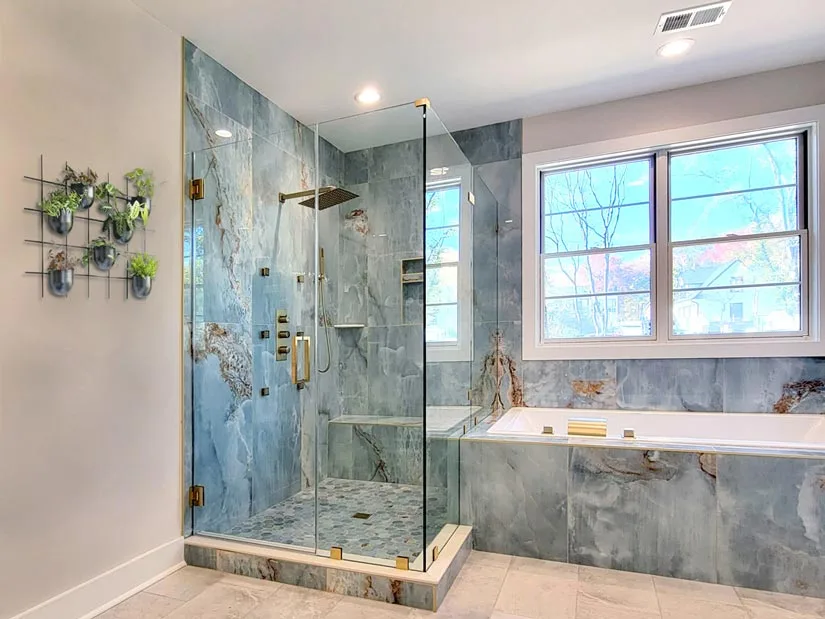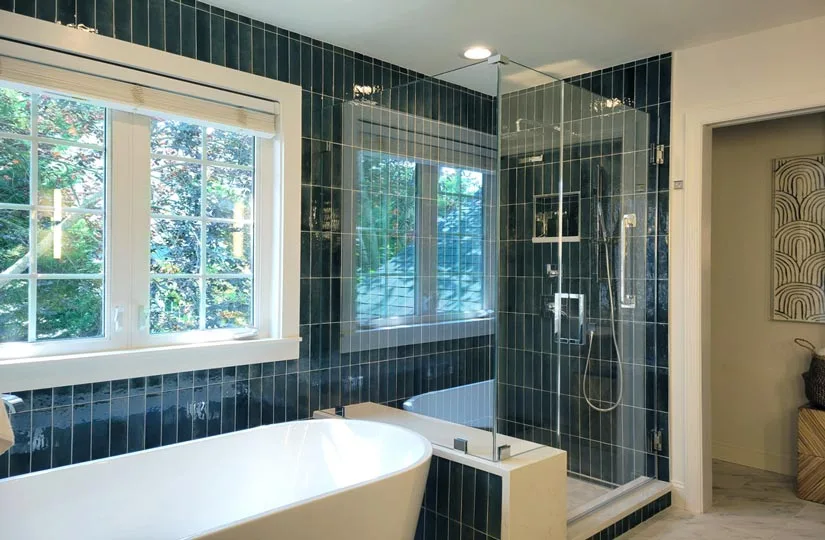
One of the best ways to improve a bathroom is by replacing the shower curtain or old framed doors with a frameless glass shower enclosure. This popular fixture instantly elevates both the shower area and the surrounding room. Due to the complexity of installation and the weight of the heavy glass, this is typically a project to entrust to the pros, like the team at ABC Glass & Mirror. Taking the time to research your options is well worth it, due to the scope of the project and the investment of money and time. With the right glass, hardware, and layout, your bathroom will be beautified with your dream shower.
1. What is a frameless shower enclosure?
2. What door options are available for a frameless glass shower?
3. Which configurations are popular for a frameless enclosure?
4. Are there diverse glass options for frameless shower doors?
5. What hardware styles are available for frameless showers?
6. How does the hardware finish impact the glass shower?
7. Are there choices that will make my frameless glass enclosure easier to clean?
8. Should I stage the interior of my shower stall once the glass doors are in place?
9. How can I have a frameless glass shower enclosure installed in my home?
10. What are best practices for cleaning a frameless glass shower?
While shower doors of old were built from glass and aluminum framing, frameless enclosures skip the framework. Instead, these units are constructed from thicker glass and fastened with clamps, hinges, and caulk. Tempered glass is used for safety because of its increased durability and how it disintegrates into chunks if broken. While many frameless glass enclosures have minimal metal, there is also the option of a frameless design with a header. Going this route, a metal header spans the top of the glass adding rigidity and providing a surface to which other pieces of hardware can be attached. While this means there is a bit more metal on your shower, it also tends to lower the price because slightly thinner glass can be used. In summary, characteristics of a frameless glass shower include:
A few different door options are popular on a frameless glass shower.
A single hinged door or set of double doors (French doors) gives elegance to the shower area. Side mount shower door hinges are available in two types – wall mount and glass-to-glass – to accommodate various layouts. This type of hinge allows the door to seal when shut and offers a classic aesthetic. Pivot hinges, on the other hand, are less noticeable. They attach the upper and lower edges of the door panel to the surfaces above and below it, which creates a pivot point from which the door can open and close. Hinges like this do not allow the door to seal, but they give the shower a modern vibe.
Hinged doors need room around the shower entrance in order to swing open conveniently. When the conditions aren’t right for this, you can choose a barn-style frameless rolling shower door instead. Hanging from a metal bar and gliding along it on rollers, this kind of door does not require any more space than a shower curtain. It melds modern frameless design with the space efficient door operation that was once only available on semi-frameless or framed bypass doors.
Finally, you can skip the door panel altogether and design a walk-in enclosure. An open entryway enhances the accessibility of the shower area, particularly if you also do a curbless entrance. This style is also fashionable and eye-catching. However, in the absence of a door to close, you need to take other measures to keep water from spraying or running onto the bathroom floor. These include:
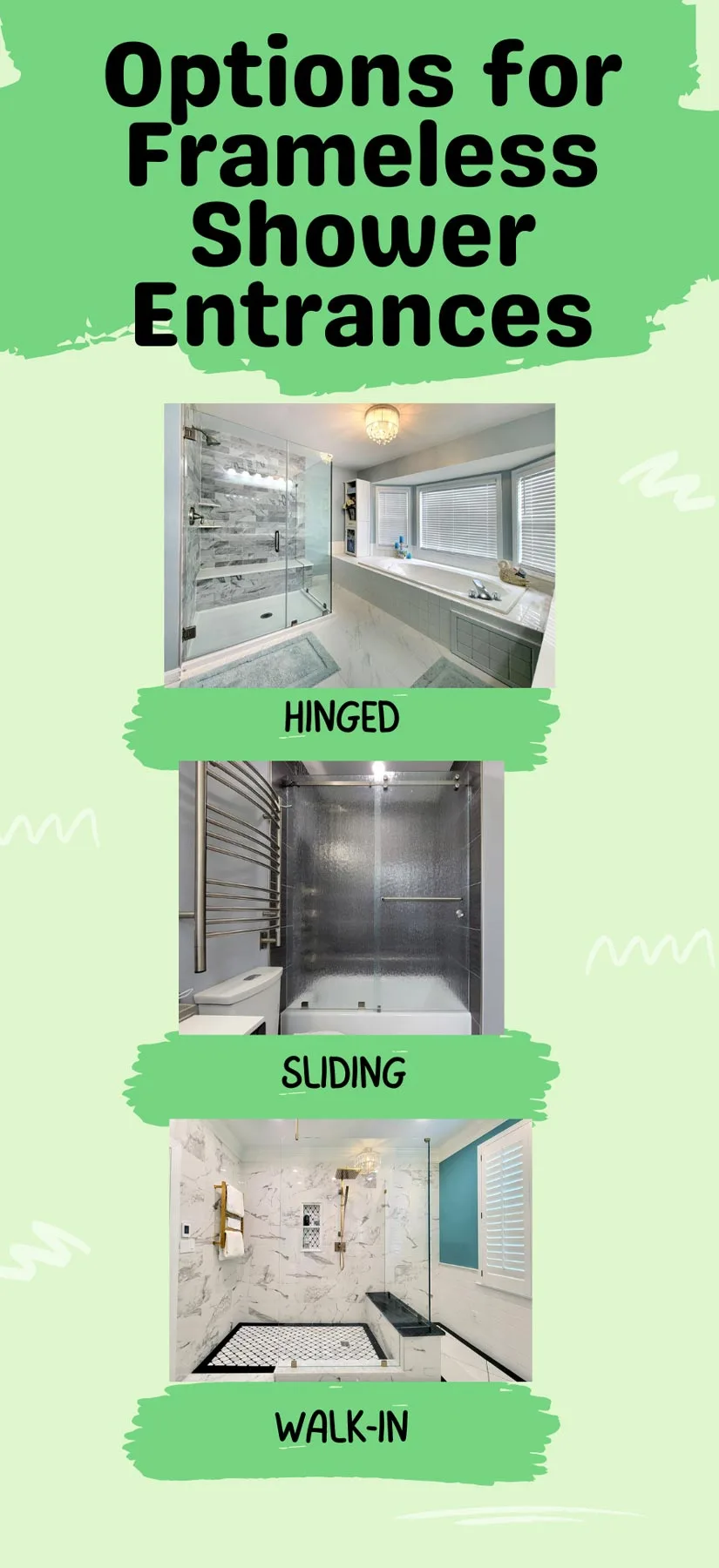
The door type is an important decision, and so is the overall layout. On many frameless glass shower enclosures, the glass panels meet other pieces of glass and the adjoining walls at right angles. Showers like this can be built in a bathroom corner (right angle corner shower) or elsewhere in the space. Within this category, options include:
Another type of frameless glass shower, is the neo-angle corner shower. Here, two pieces of glass are installed at right angles to the two walls of a bathroom corner. However, they stop well short of joining each other and are instead connected by a glass panel (often the hinged door) that meets them at 135 degree angles.
In very large bathrooms, homeowners may have an “all glass” shower room constructed in the middle of the space with all walls made of glass. On designs like this, a homeowner can choose a custom shape, number of panels, angles, and so forth.
Most definitely! In fact, choosing the glass style is one of the main ways you can customize your glass shower doors. Most homeowners and designers lean toward clear or ultra-clear glass. Standard clear glass is transparent, but there is a greenish tinge around the edge. If you want to minimize this, try ultra-clear glass which has a reduced iron content. Why is transparent glass such a favorite?
In spite of these benefits, clear glass is not the right pick for every bathroom. For example, you might want to make a more private shower area available in a guest bathroom. Likewise, it is more practical to use privacy glass in a high traffic bathroom used by siblings. You have a few options from which to choose:
Thus, the right choice of glass for your shower is determined by your practical needs, design preferences, and desired level of privacy.
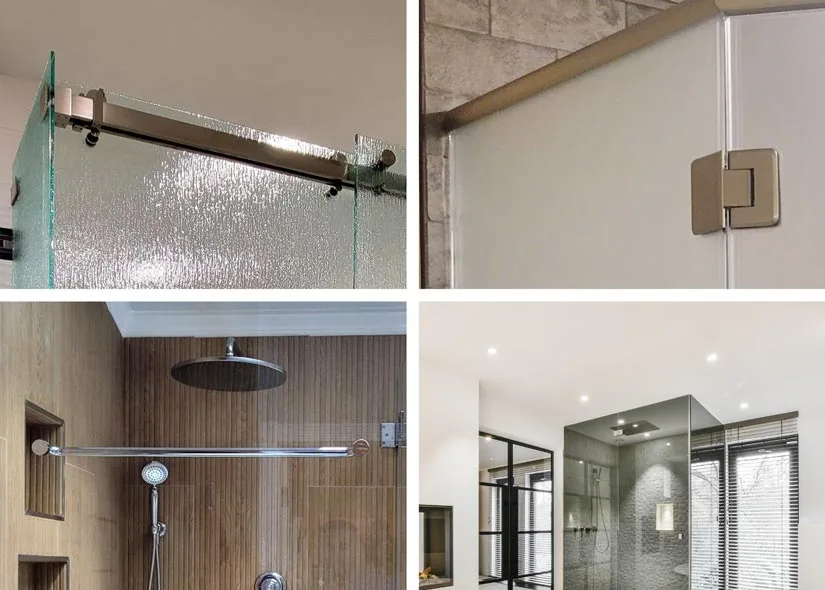
In the absence of aluminum frames, the glass on a frameless unit is held in place by hinges, clamps, and caulk joints. Hinges can be side mount, attaching the side of the door to the adjacent tiled or glass wall. Alternatively, pivot hinges fasten the door to the surfaces below and above it, forming a point from which it can pivot open and shut. Clamps join pieces of glass at angles like 90, 180, and 135 degrees.
Clamps and hinges can have square or beveled edges. A crisp, square profile gives the hardware contemporary flair, while the more traditional beveled profile creates a classic vibe. Even more variety is present in the realm of shower door pulls. There are understated tubular designs as well as ladder style handles and more. On the other hand, you could go with a knob instead, with options ranging from traditional to funky. There’s even the possibility of having a towel bar installed to serve as both the door handle and a place to hang a washcloth or towel. The contours and profiles of the hardware go a long way toward giving your glass shower enclosure its particular style.
Different hardware is used if you want a rolling shower door. Clamps may still be used for installing a fixed panel (if present), but hinges are not part of the equation. Instead, a metal bar extends across the top of the enclosure, and the door panel hangs from this. It opens by gliding along the bar on a set of rollers.
Let’s get answers to FAQs about shower hardware:

What specifications determine my hinge options?

Glass shower door hinges are rated for the width and weight of door glass they can handle.

Are there pitfalls to avoid when ordering a towel bar to be mounted on one of the glass panels.

Yes, towel bars are available in many different lengths, and you want to make sure that the one you order is not too wide for the glass.

Should all the shower hardware have the same finish?

Usually all the components used in a glass shower enclosure project have the same finish. However, this does not mean that it has to match the finish used elsewhere in the bathroom or even inside the shower stall. It is becoming more and more popular to include two or three finishes within the same room.
Frameless enclosures have much less metal than framed showers of old. However, the metal that is present does impact the style and overall vibe of the enclosure, and the finish is a key aspect of this. In modern design, one approach is to view the hardware components as adornments to the glass. As such, they will be chosen with care and intentionality. Metallic finishes used on frameless glass showers include chrome, nickel, brass, bronze, and black. Chrome is a trusted and tried finish, with popularity that may increase and decrease, even as it always remains a safe pick. Polished chrome is the go-to option if you favor this shiny, silvery, classic finish.
Turning to nickel, there are a couple options, but brushed nickel is the most common. It is less shiny than polished chrome, and its brushed finished enables it to hide fingerprints and water spots in a way that polished finishes cannot. Both chrome and nickel are cool tones that lower a room’s color temperature.
Brass is another key category of shower hardware finish. Polished brass trended a few decades ago and then brass in general saw waning popularity. It is back on the rise, but the preference is toward the softer look of satin brass. Some homeowners opt for unlacquered brass, looking forward to the development of a patina. However, the look of old unlacquered hardware might not be quite what was expected. Choosing an antique brass finish is a safer bet and one that does require waiting for time and use to change the finish. Since it is in the gold family, brass adds a touch of luxury and opulence to a shower enclosure.
Another interesting development has occurred with finishes in the bronze family. The two most well known options are:
Oil-rubbed bronze is a dark “living” finish that develops lighter highlights with time and use. Like some other finishes, it had its day in the sun, but is now infrequently picked. The softer and more subtle brushed bronze, however, is rising in popularity. While not as glamorous as brass, it too can dress up frameless shower doors.
Even though the dark oil-rubbed bronze hue is not used a lot, matte black is highly popular. It matches all color schemes and can be paired with just about any other hardware finish in a mixed metal bathroom. Matte black works with tons of decorating styles, and as a neutral it can ground a design and unite its different elements.
We’ve already looked at how your choice of hardware and glass style can impact both how often you need to clean your glass shower and how easily it cleans up. However, you can make shower glass even easier to clean by protecting it. ABC Glass & Mirror offers three long-lasting protective coating options that are applied to during fabrication: HydroClear, Pilkington OptiShower, and ShowerGuard by Guardian. While this adds to the cost at the outset, protected glass offers appealing benefits:
These three options are suitable for new installations because of the need to be applied while the glass is being fabricated and cannot be added to installed enclosures. If your enclosure is already in place, you can purchase after-market products that are rolled on or sprayed on at regular intervals. Tap water includes various levels of elements that can corrode and cloud your glass, so keeping it protected is one of the best ways to make cleaning both easier and more effective.
A clear frameless glass shower enclosure provides a clear view of the stall’s interior, which is perfect for creating a sense of spaciousness. However, it also means that if the shower area is messy or uninspiring, this will also be visible. Here are some tips for staging this area:
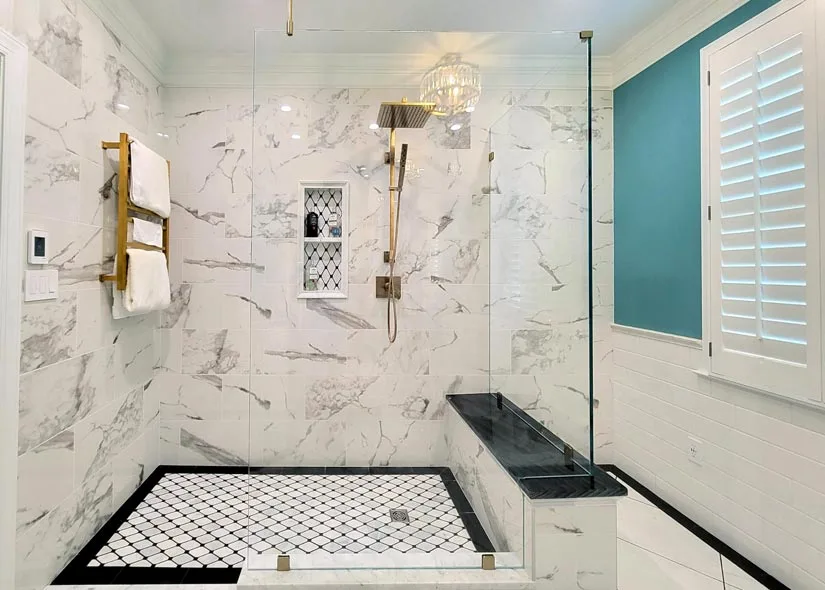
The first step toward having a custom frameless shower enclosure installed is contacting a professional glass shop like ABC Glass & Mirror. Working with us, you will have the benefit of our expertise from the project’s start to its finish. We begin by scheduling a free in-home consultation and estimate, and our glaziers can assist with pro tips and design ideas. After the consult, you’ll receive an emailed price quote, and from there the process is roughly:
To get started or to learn more, contact ABC at (703)257-7150.

In addition to protecting the glass, you can take preventative measures to improve the cleanliness and ease of cleaning of your frameless shower doors.

In summary, a custom frameless shower can be tailored to your needs and design preferences. Professional installation makes the process a breeze, and good maintenance will help it stay beautiful for years! Give ABC Glass & Mirror a ring at (703) 257-7150.
